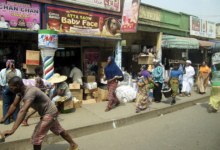
The number of people living in slums increased from 5.5 million in 2017 to 8.8 million in 2020, Ghana’s 2022 Voluntary National Review(VNR) Report on the Sustainable Development Goals(SDG) implementation, has revealed.
The figure represents an increase of about 60 per cent, according to the report which was compiled and published by the National Development Planning Commission (NDPC).
The United Nations (UN) Programme on Human Settlements defines a slum as “a contiguous settlement where the inhabitants are characterised as having inadequate housing and basic services.”
It states that such inhabitants suffer one or more ‘household deprivations’ such as lack of access to improved water sources; improved sanitation facilities; sufficient living areas; housing durability and security of tenure.
According to the report, there are about 23 slums in Ghana with 11 in Greater Accra Region. It listed predominant areas where the urban population live in slums as Accra, Tema-Ashaiman, Kumasi, Tamale and Takoradi.
Ghana’s SDGs National Coordinator and Chief Analyst at the NDPC’s Development Policy Division, Dr Richard Bofah, gave highlights of the report at a regional dissemination workshop on Friday.
The workshop afforded participants including Development Planning Officers, representatives of youth, children, women groups and persons with disabilities an opportunity to discuss Ghana’s second SDGs VNR report which was launched at the national level last month.
The document, presented at the UN High-Level Political Forum (HLPF) in July this year, showcased the country’s successes, challenges and lessons learnt in implementing the 2030 Agenda for Sustainable Development.
The issue of slums falls under SDG Goal 11 entitled “Make cities and human settlements inclusive, safe, resilient and sustainable.”
Target 11.3 states, “By 2030, enhance inclusive and sustainable urbanisation and capacity for participatory, integrated and sustainable human settlement planning and management in all countries.”
According to the report, despite the increasing number of people in slums, slum dwellers proportion of the country’s population declined from 39.3 per cent in 2017 to 28.2 per cent in 2020.
Although the report noted the government’s efforts to address the national housing deficit which the 2021 Population and Housing Census (PHC) pegs at 1.8million, it said the increasing number of people in slums was an issue of concern.
On the nature of houses, the report revealed that the urban housing shortage has led to some households using makeshift structures such as metal containers and kiosks as sleeping places or sleeping in the open.
“Data from the 2021 Population and Housing Census (PHC) indicate that about 5.6 per cent of urban housing units comprise metal containers, kiosks, wooden structures, uncompleted buildings, living quarters attached to offices/shops among others,” it said.
The VNR Report indicated that residential structures had gone up by 72.8 per cent over the last decade and structural quality and durability improved with more buildings having their outer walls made of concrete instead of mud/earth.
Commenting on progress made by the country to achieve the SDGs, DrBofah said, the country was making headway, but more needed to be done with support from all stakeholders to meet the 2030 deadline.
BY JONATHAN DONKOR







